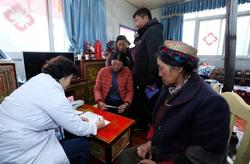 A doctor provides free consultations in Kongpo'gyada county, Nyingchi, Tibet autonomous region. (PHOTO PROVIDED TO CHINA DAILY)
A doctor provides free consultations in Kongpo'gyada county, Nyingchi, Tibet autonomous region. (PHOTO PROVIDED TO CHINA DAILY)
Dhondup Wangmo, who has long suffered from arthritis and mild anemia, can get regular health examinations since the family doctor project kicked off in Kongpo'gyada county, Nyingchi city last November.
The 79-year-old grandmother can get her blood pressure and temperature checked at the village's clinic as often as three times a month. Her basic health data have been recorded carefully by village doctors and archived in the town's medical center. If necessary, she could be immediately sent to the county hospital for treatment.
Such public health services enjoyed by Dhondup Wangmo are offered to all 35,000 people living in Kongpo'gyada. It means 29,000 herdsmen and farmers, including those scattered in remote, mountainous areas, have access to the modern healthcare system.
The family doctor project was initiated in 2017, bringing the concept of public health to the county. For the first time, each person has their own health record, which is of great significance-due to high altitude and dietary habits, residents are usually plagued by chronic illnesses such as high blood pressure, diabetes and gallbladder diseases.
The project was accelerated in late 2019 after a medical community program was promoted, which led to the integration of the county's three-tier medical resources and the adoption of digital technologies.
In Kongpo'gyada, the three-tier medical resources refer to clinics in 79 villages, medical centers in nine towns and two bigger hospitals in the county.
The clinic in the villages has two part-time medical workers responsible for basic health services: treating minor diseases such as fever and skin trauma, promoting knowledge of prevention and control of common diseases, and following up on expectant mothers and children's vaccinations.
Every kid in the village hides from me because I give them injections. But I am happy to do that.
Drolma, a self-taught doctor in Yurongzeng village
Drolma, a self-taught doctor, has worked in Yurongzeng village's clinic for 20 years. Thanks to the medical community program, she can get training on acupuncture, drugs and writing prescriptions at the town's medical center every year.
She considers such training as essential for boosting her confidence and to help her obtain a medical practitioner's license.
"Every kid in the village hides from me because I give them injections," the 36-year-old said, giggling. "But I am happy to do that."
If she sees someone with a critical illness, Drolma will call the town's medical center for help.
To improve efficiency, Tsogo's medical center was equipped with a long-distance diagnosis system in May, the first of its kind in Tibet.
ALSO READ: New impetus for online healthcare
The system enables them to initiate online consultations and share diagnoses with senior doctors in Guangdong province who can see the examination results in real-time.
The director of the medical center, Phuntsog Tashi, said a 59-year-old patient suffering from high blood pressure for 11 years was advised to try a drug that is rarely used in Tibet, and the patient's blood pressure dropped to very close to normal.
New technologies also contributed to the resources in the county's central hospital. With assistance from Zhongshan's municipal hospital in Guangdong, the central hospital has introduced minimally invasive equipment including laparoscopic and endoscopic surgical equipment since 2016.
At the same time, a total of 156 doctors, nurses and medical technicians from Zhongshan hospital have come to the county to work with local doctors. During their stay, from three months to a year, they supervise one or two resident doctors during surgeries and rounds of training.
READ MORE: Relocation project alleviates illness, poverty in Tibet
The capabilities of Kongpo'gyada county hospital has rapidly increased. In 2016, only four operations were conducted in the hospital. In 2019, a total of 168 operations were successfully completed, most of which involved the use of minimally invasive equipment.
Contact the writer at liuyi1@chinadaily.com.cn


